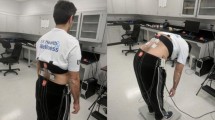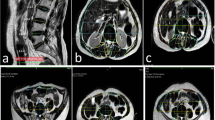Abstract
Aim
Decreased activity of the lumbar stabilizer muscles has been identified in individuals with sway-back posture. Disuse can predispose these muscles to atrophy, which is characterized by a reduced cross-sectional area (CSA) and by fat infiltration. The aim of this study was to evaluate the amount of fat infiltration in the lumbar multifidus and lumbar erector spinae muscles as a sign of the muscle atrophy in individuals with sway-back posture, with and without low back pain.
Materials and methods
Forty-five sedentary individuals between 16 and 40 years old participated in this study. The sample was divided into three groups: symptomatic sway-back (SSBG) (n = 15), asymptomatic sway-back (ASBG) (n = 15), and control (CG) (n = 15). The individuals were first subjected to photographic analysis to classify their postures and were then referred for a magnetic resonance imaging (MRI) examination of the lumbar spine. The total (TCSA) and functional (FCSA) cross-sectional areas of the lumbar erector spinae together with lumbar multifidus and isolated lumbar multifidus muscles were measured from L1 to S1. The amount of fat infiltration was estimated as the difference between the TCSA and the FCSA.
Results
Greater fat deposition was observed in the lumbar erector spinae and lumbar multifidus muscles of the individuals in the sway-back posture groups than in the control group. Pain may have contributed to the difference in the amount of fat observed in the groups with the same postural deviation. Similarly, sway-back posture may have contributed to the tissue substitution relative to the control group independently of low back pain.
Conclusions
The results of this study indicate that individuals with sway-back posture may be susceptible to morphological changes in their lumbar erector spinae and lumbar multifidus muscles, both due to the presence of pain and as a consequence of their habitual posture.




Similar content being viewed by others
References
Adam MA, Dolan P (2005) Spine biomechanics. J Biomech 38:1972–1983
Barker KL, Shamley DR, Jackson D (2004) Changes in the cross-sectional area of multifidus and psoas in patients with unilateral back pain. Spine 29:515–519
Belavý DL, Armbrecht G, Richardson CA, Felsenberg D, Hides JA (2011) Muscle atrophy and changes in spinal morphology: is the lumbar spine vulnerable after prolonged bed-rest? Spine 36:137–145
Bogduk N (2005) Clinical anatomy of the lumbar spine and sacrum, 4th edn. Elsevier, Philadelphia
Dankaerts W, O’Sullivan PB, Burnett AF, Straker LM (2006) Differences in sitting postures are associated with non specific chronic low back pain disorders when patients are subclassified. Spine 31:698–704
Danneels LA, Vanderstraeten GC, Cambier DC, Witvrouw EE, De Cuyper HJ (2000) CT imaging of trunk muscles in chronic low back pain patients and healthy control subjects. Eur Spine J 9:266–272
Elliot JM, O’Leary S, Sterling M, Hendrikz J, Pedler A, Jull G (2010) Magnetic resonance imaging findings of fatty infiltrate in the cervical flexors in chronic whiplash. Spine 35:948–954
Hides J (2004) Paraspinal mechanism in low back pain. In: Richardson C, Hodges P, Hides J (eds) Therapeutic exercise for lumbopelvic stabilization: a motor control approach for the treatment and prevention of low back pain, 2nd edn. Churchill Livingstone, Sydney, pp 149–161
Hides JA, Gilmore C, Stanton W, Bohlscheid E (2008) Multifidus size and symmetry among chronic LBP and healthy asymptomatic subjects. Man Ther 13:43–49
Hyun JK, Lee JY, Lee SJ, Jeon JY (2007) Asymmetric atrophy of multifidus muscle in patients with unilateral lumbosacral radiculopathy. Spine 32:E598–E602
Kamaz M, Kiresi D, Oğuz H, Emlik D, Levendoğlu F (2007) CT measurement of trunk muscle areas in patients with low back pain. Diagn Inter Radiol 13:144–148
Kang CH, Shin MJ, Kim SM, Lee SH, Lee CS (2007) MRI of paraspinal muscles in lumbar degenerative kyphosis patients and control patients with chronic low back pain. Clin Radiol 62:479–486
Keller A, Gunderson R, Reikeras O, Brox JI (2003) Reliability of computed tomography measurements of paraspinal muscle cross-sectional area and density in patients with chronic low back pain. Spine 28:1455–1460
Kendall FP, McCreary EK, Provance PG, Rodgers MM, Romani WA (2005) Muscles: testing and function with posture and pain, 5th edn. Lippincott Williams and Wilkins, Philadelphia
Kjaer P, Bendix T, Sorensen JS, Korsholm L, Leboeuf-Yde C (2007) Are MRI-defined fat infiltrations in the multifidus muscles associated with low back pain? BMC Med 5:1–10
Magee DJ (2007) Orthopedic physical assessment, 5th edn. Saunders, Philadelphia
Mengiardi B, Schmid MR, Boos N, Pfirrmann CWA, Brunner F, Elfering A, Hodler J (2006) Fat content of lumbar paraspinal muscles in patients with chronic low back pain and in asymptomatic volunteers: quantification with MR spectroscopy. Radiology 240:786–792
Mitchell T, O’Sullivan PB, Burnett AF, Straker L, Smith A (2008) Regional differences in lumbar spinal posture and the influence of low back pain. BMC Musculoskelet Disord 9:1–11
Norris CM, Berry S (1998) Occurrence of common lumbar posture types in the student sporting population: an initial investigation. Sports Exerc Inj 4:15–18
O’Sullivan PB (2004) Clinical instability of the lumbar spine: its pathological basis, diagnosis and conservative management. In: Boyling JD, Jull GA (eds) Grieve’s modern manual therapy: the vertebral column, 3rd edn. Elsevier, Philadelphia, pp 311–321
O’Sullivan PB, Grahamslaw M, Kendell M, Lapenskie SC, Moller NE, Richards KV (2002) The effects of different standing and sitting postures on trunk muscle activity in a pain-free population. Spine 27:1238–1244
O’Sullivan PB, Mitchell T, Bullich P, Waller R, Holte J (2006) The relationship between posture and back muscle endurance in industrial workers with flexion related low back pain. Man Ther 11:264–271
Perry M, Smith A, Straker L, Coleman J, O’Sullivan PB (2008) Reliability of sagittal photographic spinal posture assessment in adolescents. Adv Physiother 10:66–75
Ranson C, Burnett A, Kerslake R, Batt ME, O’Sullivan PB (2006) An investigation into the use of MRI imaging to determine the functional cross sectional area of lumbar paraspinal muscles. Eur Spine J 15:764–773
Ranson C, Burnett A, O’Sullivan PB, Batt M, Kerslake R (2008) The lumbar paraspinal muscle morphometry of fast bowlers in cricket. Clin J Sports Med 18:31–37
Reeve A, Dilley A (2009) Effects of posture on the thickness of transversus abdominis in pain-free subjects. Man Ther 14:679–684
Roussouly P, Gollogly S, Berthonnaud E, Dimnet J (2005) Classification of the normal variation in the sagittal alignment of the human lumbar spine and pelvis in the standing position. Spine 30:346–353
Sahrmann SA (2002) Diagnosis and treatment of movement impairment syndromes. Mosby, St. Louis
Seah SHH, Briggs AM, O’Sullivan PB, Smith AJ, Burnett AF, Straker LM (2011) An exploration of familial associations in spinal posture defined using a clinical grouping method. Man Ther 16(5):501–509
Smith A, O’Sullivan PB, Straker LC (2008) Classification of sagittal thoraco-lumbo-pelvic alignment of the adolescent spine in standing and its relationship to low back pain. Spine 33:2101–2107
Acknowledgments
Acknowledgments are due to Fundação de Apoio ao Ensino, Pesquisa e Assistência (FAEPA), Hospital das Clínicas da Faculdade de Medicina de Ribeirão Preto da Universidade de São Paulo, for the financial support provided under No. 97/2008 for the development of the present study.
Conflict of interest
None.
Author information
Authors and Affiliations
Corresponding author
Rights and permissions
About this article
Cite this article
Pezolato, A., de Vasconcelos, E.E., Defino, H.L.A. et al. Fat infiltration in the lumbar multifidus and erector spinae muscles in subjects with sway-back posture. Eur Spine J 21, 2158–2164 (2012). https://doi.org/10.1007/s00586-012-2286-z
Received:
Accepted:
Published:
Issue Date:
DOI: https://doi.org/10.1007/s00586-012-2286-z




